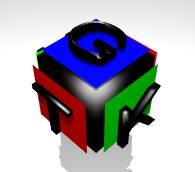|
|
| This document is available in: Castellano ChineseGB Deutsch English Francais Italiano Nederlands Russian Turkce |

by Özcan Güngör <ozcangungor(at)netscape.net> About the author: I'm doing at the moment my military service as Linux, Oracle administrator and web programmer. Content: |
GUI Programming with GTK - 3
Abstract:
In these article series, we will learn how to write graphical user interfaces (GUIs) using GTK. I do not have any idea how long it will last. In order to understand these articles, you should know the following about the C programming language:
GUI Programming with GTK, GUI Programming with GTK - 2 . This article is a little bit shorter than the others as I'm doing my military service. |
This button looks like a normal button but has two states: Pressed or not. To create a toogle button one of the following function is used:
GtkWidget *toggle=gtk_toggle_button_new(void); GtkWidget *toggle=gtk_toggle_button_new_with_label(const gchar *label);
The first function creates a toggle button without a text label
in it but the second one creates it with the string label on
it.
You can set its state with the following function:
gtk_toggle_button_set_active (GtkToggleButton *toggle_button,
gboolean is_active);
where toggle_button is the button whose state you want to change and is_active is the state (0 or 1). When it is 0, then the button is not in "pressed" state; when it is 1, the button is in "pressed" state.
To get the state of the button, the following function can be used:
gboolean gtk_toggle_button_get_active(GtkToggleButton *button);
The "toggled" event can be connected to a toggle button.
Here is an example:
#include <gtk/gtk.h>
void togg(GtkWidget *widget, gpointer *data){
if (gtk_toggle_button_get_active(GTK_TOGGLE_BUTTON(data)))
g_print("State is 1\n");
else
g_print("State is 0\n");
}
int main( int argc,char *argv[] )
{
GtkWidget *window;
GtkWidget *button;
gtk_init (&argc, &argv);
/* Create a new window */
window = gtk_window_new (GTK_WINDOW_TOPLEVEL);
gtk_window_set_title (GTK_WINDOW (window), "Toggle Button");
/* Connect destroy event to the window. */
gtk_signal_connect (GTK_OBJECT (window), "destroy",
GTK_SIGNAL_FUNC(gtk_main_quit), NULL);
/* Creates a toggle button */
button=gtk_toggle_button_new_with_label("I'm a toggle button");
/* Add the button to window */
gtk_container_add(GTK_CONTAINER(window),button);
/* Connect "toggled" event to the button */
gtk_signal_connect (GTK_OBJECT (button), "toggled",
GTK_SIGNAL_FUNC(togg),(gpointer *)button);
gtk_widget_show(button);
gtk_widget_show (window);
gtk_main ();
return(0);
}
The check button ( it is also known as check box ) is a subclass
of the toggle button. It can be used to select some options.
To create a check button, the following fuction is used:
GtkWidget* gtk_check_button_new (void); GtkWidget* gtk_check_button_new_with_label (const gchar *label);
The explanations are the same as for toggle button.
The example :
#include <gtk/gtk.h>
void togg(GtkWidget *widget, gpointer *data){
if (gtk_toggle_button_get_active(GTK_TOGGLE_BUTTON(data)))
g_print("State is 1\n");
else
g_print("State is 0\n");
}
int main( int argc,char *argv[] )
{
GtkWidget *window;
GtkWidget *button;
gtk_init (&argc, &argv);
/* Create a new window */
window = gtk_window_new (GTK_WINDOW_TOPLEVEL);
gtk_window_set_title (GTK_WINDOW (window), "Check Button");
/* Connect destroy event to the window. */
gtk_signal_connect (GTK_OBJECT (window), "destroy",
GTK_SIGNAL_FUNC(gtk_main_quit), NULL);
/* Creates a check button */
button=gtk_check_button_new_with_label("I'm a check button");
/* Add the button to window */
gtk_container_add(GTK_CONTAINER(window),button);
/* Connect "toggled" event to the button */
gtk_signal_connect (GTK_OBJECT (button), "toggled",
GTK_SIGNAL_FUNC(togg), (gpointer *)button);
gtk_widget_show(button);
gtk_widget_show (window);
gtk_main ();
return(0);
}
Labels let you put any text anywhere in window.
To create a label just use the following function:
GtkWidget* gtk_label_new(const gchar *text);
With the function
gtk_label_set_text(GtkLabel *label, gchar *text);
you can change the string on a label at anytime.
gtk_label_set_justify(GtkLabel *label, GtkJustification jtype);
The gtk_label_set_justify funtion is used to justify the text on the label. jtype can be
gtk_label_set_line_wrap (GtkLabel *label,gboolean wrap);
is used to make the text splittable into many pieces when the text is longer than the place it should fit. When wrap is 1, then text will wrap to the next line, otherwise not.
gtk_label_get(GtkLabel *label, gchar **str)
is used to get the text on the label into str.
Tooltip is a text that appears when the mouse is on a widget. For example, you can set a tip for a button and the text "send the information" appears when your mouse is over it.
To do that a GtkToolTips widget must be created first:
GtkToolTips* gtk_tooltips_new();
Then this tooltip is attached to a widget:
gtk_tooltips_set_tip(GtkTooltips *tooltips, GtkWidget *widget,
const gchar *tip_text,const gchar *tip_private);
A little example:
#include <gtk/gtk.h>
int main( int argc,char *argv[] )
{
GtkWidget *window;
GtkWidget *button;
GtkTooltips *tip;
gtk_init (&argc, &argv);
/* Create a new window */
window = gtk_window_new (GTK_WINDOW_TOPLEVEL);
gtk_window_set_title (GTK_WINDOW (window), "Tooltips");
/* Connect destroy event to the window. */
gtk_signal_connect (GTK_OBJECT (window), "destroy",
GTK_SIGNAL_FUNC (gtk_main_quit), NULL);
/* Creates a button */
button=gtk_button_new_with_label("I'm a Button");
/* Add the button to window */
gtk_container_add(GTK_CONTAINER(window),button);
/* Creates a tooltips*/
tip=gtk_tooltips_new();
/* Attache this tooltips to button with text*/
gtk_tooltips_set_tip(tip, button, "Click me!",NULL);
gtk_widget_show(button);
gtk_widget_show (window);
gtk_main ();
return(0);
}
Some other functions:
gtk_tooltips_enable (GtkTooltips *tooltips);
Enables the tooltips.
gtk_tooltips_disable (GtkTooltips *tooltips);
Disables tooltips.
To get any tooltip data of a wigdet, we need
GtkTooltipsData* gtk_tooltips_get_data(GtkWidget *widget);
GtkTooltipsData is a struct in the following way:
struct _GtkTooltipsData
{
GtkTooltips *tooltips;
GtkWidget *widget;
gchar *tip_text;
gchar *tip_private;
GdkFont *font;
gint width;
GList *row;
};
To set the delay of the appearing text,
gtk_tooltips_set_delay (GtkTooltips *tip, guint delay)
A combo box is an editable text field combined with a pull-down menu. You can enter a value or select one of the pull-down entries.
A combo box can be created with
GtkWidget *gtk_combo_new();
And we need a list of options which is a GList struct.
GList *glist=NULL;
And the options can be appended to the list with
GList *g_list_append(GList *list, gchar *option);
Then this list needs to be added to the combo box
gtk_combo_set_popdown_strings(GtkCombo *combo, GList *List);
The combo box is ready. To read the selected option use:
gchar *gtk_entry_get_text(GtkEntry *entry);
entry is GTK_ENTRY(GTK_COMBO(combo)->entry)) in this case.
gtk_combo_set_use_arrows(GtkCombo *combo,gint val);
This function is used to enable or disable up/down keys on the keyboard to change the value on a combo box. When val is 0, these keys do not function, otherwise these keys change the value. But when the value on a combo box is different from the values in the list, these keys don't function.
gtk_combo_set_use_arrows_always(GtkCombo *combo,gint val);
This function is the same as gtk_combo_set_use_arrows but when the value on a combo box is different form the values in the list, these keys function.
gtk_combo_set_value_in_list(GtkCombo *combo, gboolean val,
gboolean ok_if_empty);
When val is 1, you can enter a value in the list. When ok_if_empty is 1, the value may be blank.
#include <gtk/gtk.h>
void act(GtkWidget *widget, gpointer *data){
g_print((gchar *)data);
}
int main( int argc,char *argv[] ) {
GtkWidget *window;
GtkWidget *combo;
GtkWidget *button;
GtkWidget *box;
GList *list=NULL;
list=g_list_append(list,"Slackware");
list=g_list_append(list,"RedHat");
list=g_list_append(list,"SuSE");
gtk_init (&argc, &argv);
/* Create a new window */
window = gtk_window_new (GTK_WINDOW_TOPLEVEL);
gtk_window_set_title (GTK_WINDOW (window), "Combo Box");
/* Connect destroy event to the window. */
gtk_signal_connect (GTK_OBJECT (window), "destroy",
GTK_SIGNAL_FUNC(gtk_main_quit), NULL);
/* Create a new horizontal box */
box=gtk_hbox_new(1,0);
gtk_container_add(GTK_CONTAINER(window),box);
/* Creates a combo box */
combo=gtk_combo_new();
/* Sets the list */
gtk_combo_set_popdown_strings(GTK_COMBO(combo),list);
/* Enables up/down keys change the value. */
gtk_combo_set_use_arrows_always(GTK_COMBO(combo),1);
gtk_box_pack_start(GTK_BOX(box), combo,1,1,1);
button=gtk_button_new_with_label("Write it");
gtk_signal_connect(GTK_OBJECT(button),"clicked",GTK_SIGNAL_FUNC(act),
gtk_entry_get_text(GTK_ENTRY(GTK_COMBO(combo)->entry)));
gtk_box_pack_start(GTK_BOX(box), button,1,1,1);
gtk_widget_show(box);
gtk_widget_show(combo);
gtk_widget_show(button);
gtk_widget_show (window);
gtk_main ();
return(0);
}
All comments are welcome.
|
Webpages maintained by the LinuxFocus Editor team
© Özcan Güngör "some rights reserved" see linuxfocus.org/license/ http://www.LinuxFocus.org |
Translation information:
|
2005-12-21, generated by lfparser version 2.53